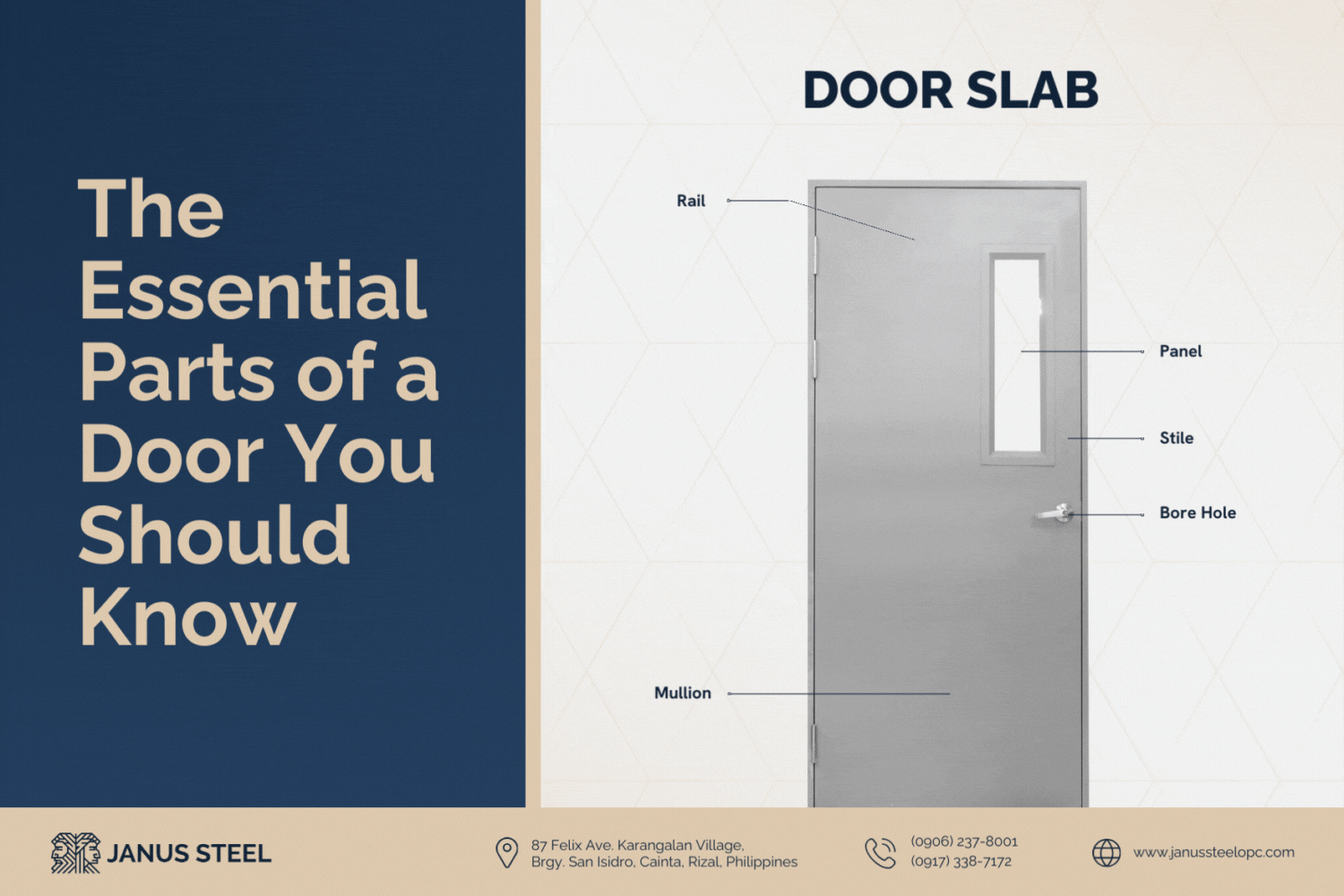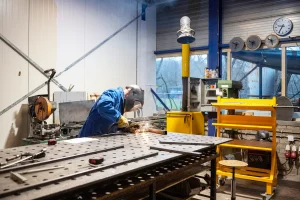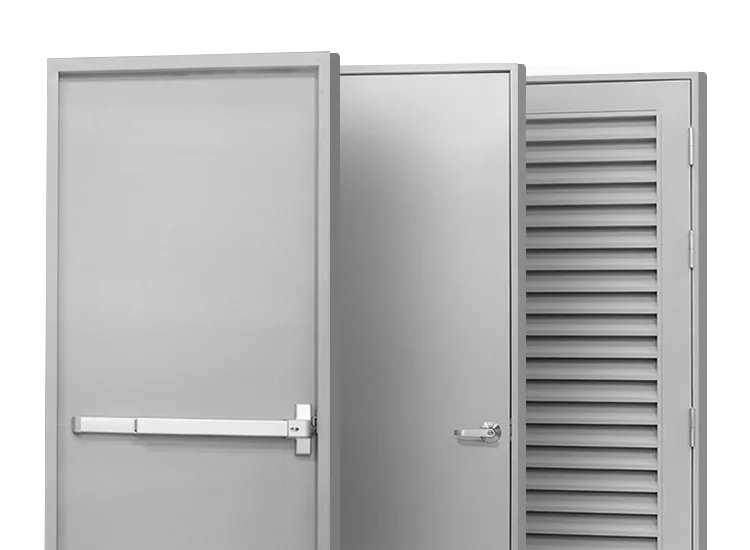Doors are crucial architectural elements that serve both practical and aesthetic purposes. They play a fundamental role in any structure by providing privacy, security, and enhancing its overall style. However, for a door to function effectively, it relies on several essential components.
In this article, we will explore the various parts of a door and analyze each component to understand their roles in ensuring doors perform properly across different types of structures. Read on.
What is a Door?
A door is a movable barrier, typically made of wood, metal, or glass, that is installed at an entryway to allow access to any property. Doors serve multiple functions in a space: they increase isolation by dividing rooms, they regulate entry and exit, and they contribute to the overall aesthetic appeal of the place. They are also important for regulating the passage of light, air, and temperature in any construction or property.
And depending on their installation location or the particular requirements of the area they are intended to safeguard or grant access to, they might be classified as either interior or exterior doors. How do these door types differ? Check below:
Exterior Doors
Exterior doors are designed to provide the first line of defense against the elements and unauthorized entry. They are often more strong and durable than interior doors, and often offer enhanced insulation and security features. Exterior doors are also available in a variety of forms, including front doors, patio doors, and garage doors, with each serving a distinct functional and aesthetic purpose.
Interior Doors
Interior doors are the ones that separate rooms and areas within a building, usually found inside of a house or other structure. Unlike exterior doors, which are intended to endure the weather and provide protection, interior doors are primarily used to create privacy, reduce noise, and make aesthetic separations between various living spaces or rooms.

The Essential Parts of a Door You Should Know
Learning the different parts of a door is important, especially if you are anyone engaged in new building or home remodeling projects. This is due to the fact that doors are complicated pieces made up of multiple components, each of which is crucial to ensure their longevity and functionality.
So, whether you’re installing a new door, repairing an old one, or simply changing the way it works, learning how each component contributes to the door’s overall performance is critical for a successful project completion. And to help you understand the parts of a door, here’s a breakdown of each component:
Door Slab
A door slab is the flat, rectangular part of a door that fits into the door frame. It is basically the portion of the door that you see and interact with. Typically, it refers to the door alone, without any other parts.
Parts of Door Slab
- Panel: This is the flat, raised, or recessed sections that adds both structural stability and aesthetic appeal to the door. They can vary in design, and are often found in traditional and decorative doors.
- Rail: Rails are the horizontal parts of a door slab. They are typically found on the top, bottom, or middle of the door that usually help to frame the panels and help hold the door together.
- Stile: These are the vertical parts of the door frame on the left and right sides. It supports the panels and rails, and are essential for the door’s strength and stability.
- Mullions: Mullions are aesthetic dividers that separate different parts of a door. They are usually used in doors with multiple panels or glass inserts to provide additional support.
- Bore Hole: This one is the pre-drilled hole in the door slab that accommodates the door hardware, making sure it is securely mounted and operated properly.
Door Frame
A door frame is a structure made from wood, metal, or composite materials that surrounds and supports a door. It consists of several components including:
Parts of a Door Frame
- Jamb: The vertical part of a door frame that holds the door in place. It has two side jambs and a head jamb at the top.
- Casing: This component is the decorative molding that encircles the door frame and fills in any spaces left between the door and the floor. It comes in a range of sizes and styles and enhances the appearance of the door as well.
- Sill: This is the bottom part of a door frame that rests on the ground seals the space between the door and the ground to keep moisture and drafts out.
- Threshold: This is a piece of material, usually made of wood or metal, that is positioned above the sill to improve the seal at the bottom of the door and provide a seamless transition between floor surfaces.
- Door Stop: This one keeps the door from swinging past the closed position. It is a thin strip of metal or wood fastened to the door frame. When closed, it fits snugly along the top and sides of the frame.
- Strike Plate: The strike plate is the metal component that is fastened to the door frame at the location where the deadbolt or latch engages. It strengthens the frame and guarantees that the door stays secured and sturdy.
Rough Opening
A rough opening (RO) is a framed gap in a wall where a door will be mounted. It covers the space between the studs, header, and sill and is somewhat larger than the actual door frame to allow for adjustments and proper fitting.
Parts of a Rough Opening
- Header: This part is the horizontal beam that spans the top of the rough opening. It provides structural support and helps to distribute the load above the door, while maintaining the structural integrity of the wall above the door.
- King Stud: King studs are the vertical studs on either side of the rough opening. They run from the floor to the ceiling and provide support for the header.
- Trimmer Stud: Also known as jack studs, trimmer studs are shorter studs that extend from the floor to the bottom of the header. These are usually attached to the king studs, helping to distribute the weight of the header and door evenly.
- Subfloor: This is a layer of material that rests on top of the floor joists. It bears the weight of the door and frame and serves as a foundation for the completed flooring.
- Sheathing: Sheathing is the layer of a plywood or OSB that covers the exterior walls of a building. It adds structural strength and provides additional support for the door frame.
Door Hardware
Door hardware refers to the different components and accessories used in the installation and operation of doors. This includes everything from the handles and locks to the hinges that enable a door to function properly.
Parts of a Door Hardware
- Hinge: this door hardware fastens the door to the frame so that it can open and close, and are accessible in a range of finishes and designs.
- Handle: It is a hardware device used to open and close doors. It is a key component of door systems, allowing users to operate the door by gripping, turning, pushing, or pulling it.
- Latch: A mechanical system used to lock a door, gate, or hatch shut. Usually, it is made up of a bolt or bar that slides into a catch or socket that holds the door closed.
- Deadbolt: It is a type of locking mechanism often used in conjunction with a traditional door handle or knob to provide an extra layer of security.
- Door Sweep: A strip of rubber or metal attached to the door bottom, sealing the gap between door and floor to prevent drafts and moisture, enhancing energy efficiency.
- Strike Plate: A metal plate on the door frame where the latch or deadbolt engages, reinforcing the frame and ensuring door security.
- Lockset: This is a combination of handle, latch, and sometimes deadbolt, forming the complete locking mechanism.
- Weather-stripping: This rubber or foam material is used around the door frame edges to close gaps, enhance insulation, and lessen drafts.

Get a Door with Top-Quality Parts, Go for Janus Steel Door Today!
Overall, understanding the different parts of a door and their functions is vital before choosing a door for your building project. As each component plays a crucial role in the overall performance and aesthetics of any door, whether it’s made of wood or steel. But if you already know this and are ready to choose a door for your project, then Janus Steel is the leading supplier you can trust. Our steel doors come complete with all the necessary parts and offer the perfect blend of functionality, security, and style that you won’t regret.
Explore our collection of steel doors now and experience the difference that quality craftsmanship can make.





